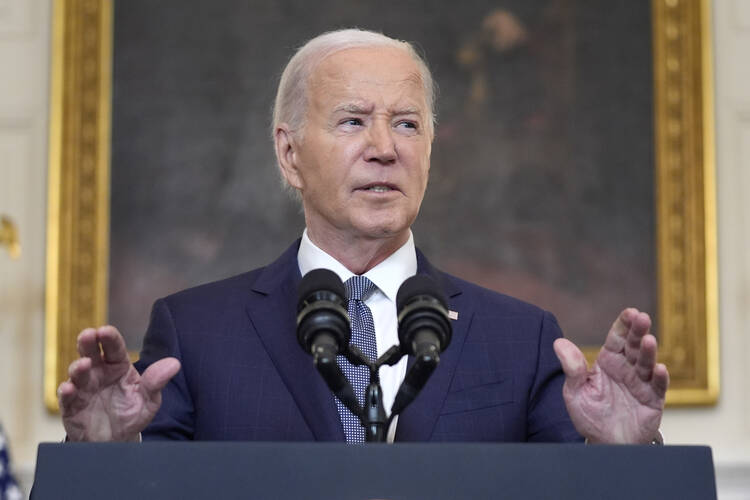On May 31, President Biden made a surprise announcement endorsing a plan to end the war in Gaza that he said was put forward by Israel. Mr. Biden’s choice to discuss the plan publicly before Israel did so itself was a way of pressuring Israeli Prime Minister Benjamin Netanyahu to work for a cease-fire. But for any such plan to move forward, significant additional pressure must be brought to bear both on Hamas—likely via Qatar—and on Israel, in the form of conditioning American military and diplomatic support on a commitment to end hostilities.
The three-phase plan Mr. Biden described would begin with a temporary cease-fire accompanying the release of many Israeli hostages and Palestinian detainees, a return to north Gaza for displaced Gazans, and continued negotiations between Israel and Hamas toward a permanent cease-fire. Subsequent phases would see additional hostage and prisoner exchanges and Israeli withdrawal from Gaza, then finally a period of reconstruction.
Though this plan has received significant support from the international community and a coalition representing the families of hostages, neither Hamas nor Israel have committed to it. Mr. Netanyahu said Monday that he is open to a temporary cease-fire to return hostages, but he insists on a provision allowing for Israel to resume fighting should negotiations break down.
That position risks preventing the return of the 81 Israelis who are believed to remain in Gaza after being taken hostage on Oct. 7, and the remains of 39 who have been declared dead in absentia by Israeli authorities. Israeli National Security Adviser Tzachi Hanegbi reportedly told hostages’ families in a meeting on May 30: “This government will not make a decision to stop the war for the return of all the hostages.”
The day before Mr. Biden revealed and endorsed the cease-fire proposal, Mr. Hanegbi said on Israeli public radio that the fighting, aimed at bringing about “the destruction of the military and governing capabilities of both Hamas and the Islamic Jihad,” would continue for “at least another seven months.”
Whether or not Mr. Biden’s speech was in direct response to Israel’s contemplation of the war extension, he is increasingly willing to establish distance between his position and that of Mr. Netanyahu and his government. In an interview with Time magazine, conducted on May 28 but published on June 4, Mr. Biden was asked whether Mr. Netanyahu was “prolonging the war for his own political self-preservation” and responded, “There is every reason for people to draw that conclusion.”
In Israel, Mr. Netanyahu faces resistance to the cease-fire deal from two ultranationalist members of his coalition, National Security Minister Itamar Ben-Gvir and Finance Minister Bezalel Smotrich, who said the plan would not meet Israel’s stated goal of the destruction of Hamas and threatened to pull their parties from the government, risking Mr. Netanyahu’s position as the head of the Israeli state.
Mr. Biden should make it clear that the United States will not continue to support a war whose terms are dictated by extremists like Mr. Ben-Gvir and Mr. Smotrich. Both men oppose a two-state solution and endorse permanent Israeli occupation and the rebuilding of Israeli settlements in Gaza.
If Mr. Netanyahu is unwilling to take the political risk of moving toward a cease-fire, Mr. Biden should respond with a withdrawal of all U.S. military aid used to support Israel’s Gaza offensive, as he did in a very limited way in early May, trying to hold Israel back from its attack on Rafah. The United States was right to come to Israel’s aid in the wake of Hamas’s horrific attack on Oct. 7, and should continue to supply defensive aid for Israel to protect itself from rocket attacks, but that does not mean it must continue to provide material and diplomatic support for Israel’s war against Gaza.
In February, when there was a brief glimmer of hope that Israel and Hamas might be near a negotiated cease-fire, the editors of America wrote that “War must be a last resort and once joined, wars must have an end, both in the sense of an ultimate goal of peace and in the sense of being able to finally conclude.” Significantly, in his May 31 address, Mr. Biden said that Hamas is “no longer capable of carrying out another October 7th.” As that end has been achieved, so too the death and destruction in Gaza must come to an end.
Pope Francis has repeatedly said that “war is always a defeat,” but on May 11, he added that war is also “a deception.” The idea that conflicts can be decided solely through the imposition of fear, whether by trying to expel a superior power by murder and hostage-taking or by trying to root out terrorist ideologies out of a population through military force, are such deceptions. The threat Hamas poses to Israel is more than an armed force that can be “destroyed”; it is a violent ideology fueled by hatred of the other. That ideology will not be eliminated through further violence. On the contrary, further devastation in Gaza could serve as a hotbed for the radicalization of future generations.
Some of Mr. Netanyahu’s political partners have made it clear that their vision for the future of Gaza is continued violence, conflict and occupation, presumably until the Palestinian population is entirely displaced. No matter how the U.S. commitment to supporting Israel’s security is understood, there is no lasting security along that path. Terrorist ideologies can only be overcome when a peaceful model of coexistence is put forward—and no one waging this war has put forth any such plan for the day after the war concludes.
Mr. Biden’s choice to push publicly for Israel to make a decisive move in that direction is hopeful. But it is likely that he and other American leaders will need to apply continued and even greater pressure for any hope of a lasting peace to be made real.








